Notice: I receive compensation if you buy something through affiliate links on this post. This does not change the price you would pay.
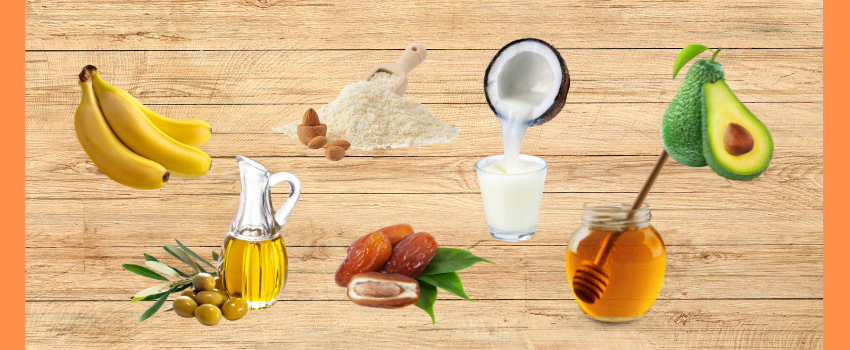
You stand there gawking at a slice of decadent cake and thinking, “Do I really need that extra gym session?”
The tantalizing tango between taste buds and guilt can be a tough one.
And as a home baker, the desire to whip up something lusciously indulgent yet worry-free for the family – it’s not just a dream, it’s a dilemma.
But what if you could have your cake and eat it, minus the guilt?
I have a genetic predisposition to diabetes. I’m also battling severe digestive issues.
I have many food intolerances, including dairy, eggs, wheat flour, and nuts.
Whoa! Those are most of the ingredients in my only craving: chocolate and anything with it.
We, who love baking, also delight in taking bites of our creations because what’s the point if we can’t?
But let’s admit it. Our masterpieces feed the senses, but they are also health risks.
Must I deny myself my only indulgence?
Thankfully, I soon learned I don’t have to because there’s a way to skirt the health issues.
Yes, we can transform our kitchens into guilt-free dessert factories with healthy baking substitutes.
Buckle up because we’re about to dive into the ultimate guide to baking the healthy way.
No more second thoughts, no more guilt.
Let’s explore which ingredients you can substitute with healthier and more nutritious options, their proportions, and possible effects on taste and texture.
You’ll also learn if you need to adjust other ingredients and baking elements.
There’s more because you’ll get tips and techniques for successful, healthy baking.
Let’s get the oven hot.
Table of Contents
Baking Better: Understanding Healthy Baking
The delectable sweets that make our senses float have had a bad rap lately because of the rise in chronic lifestyle diseases worldwide.
My doctor bluntly described them as nutritionally bereft.
White sugar, bleached flour, and unhealthy fats can make those cookies less appealing when watching your health.
But have you ever stopped to think about their nutritional value? Or rather, the lack thereof?
What is healthy baking?
It’s about making wiser choices.
The best way to do it is through healthy baking substitutes.
But it’s not always about using less sugar, fat, or calories. The magic lies in balancing taste and nutrition.
It shouldn’t be a “one size fits all” approach because each individual’s health profile is unique.
Some may have issues with foods known to elevate blood sugar but not with eggs. So, they might want to eliminate sugar and white flour.
I avoid dairy. Others may be allergic to eggs and nuts. Still, others just want their treats to be more nutritious.
The point: you don’t have to eliminate every traditional ingredient.
Indeed, healthy baking is your ally if you want to be healthy and nourished while indulging your taste buds. Isn’t that a treat?
The Art and Concept of Ingredient Substitutions
How do you approach healthy baking?
The most popular and effective method is through ingredient substitutions. It’s the art and science of swapping traditional baking staples with healthier alternatives that pack more nutritional punch.
You don’t remove an ingredient just because the replacement is less nasty. You should also consider the substitute’s nutritional profile. As the cliche goes: “Hit two birds with one stone.”
Indeed, you don’t have to sacrifice the sinful taste of your favorite chocolate chip cookie for health because you can have both.
But there’s a catch. Every ingredient swap alters the flavor and texture of baked goods, so you may have to adjust other ingredients as well.
The trick is to tread with caution and experiment.
Keep reading, and you’ll discover it’s not that difficult.
What Are Healthy Baking Substitutes?: Ingredient Swaps Decoded
The beauty of baking is the array of ingredients you can play around with. Let’s look at what you can swap for traditional ingredients.
1. Healthy Baking With Sugar Substitutes
Sugar alternatives in baking can significantly reduce refined sugars in baked goods. Natural sweeteners like honey, maple syrup, or dates sweeten and add unique flavors and health benefits. But mind the consistency because they can make your batter more liquid.
Table 1 below summarizes known sugar substitutes, their ratios, tips, and what you need to look out for or adjust.
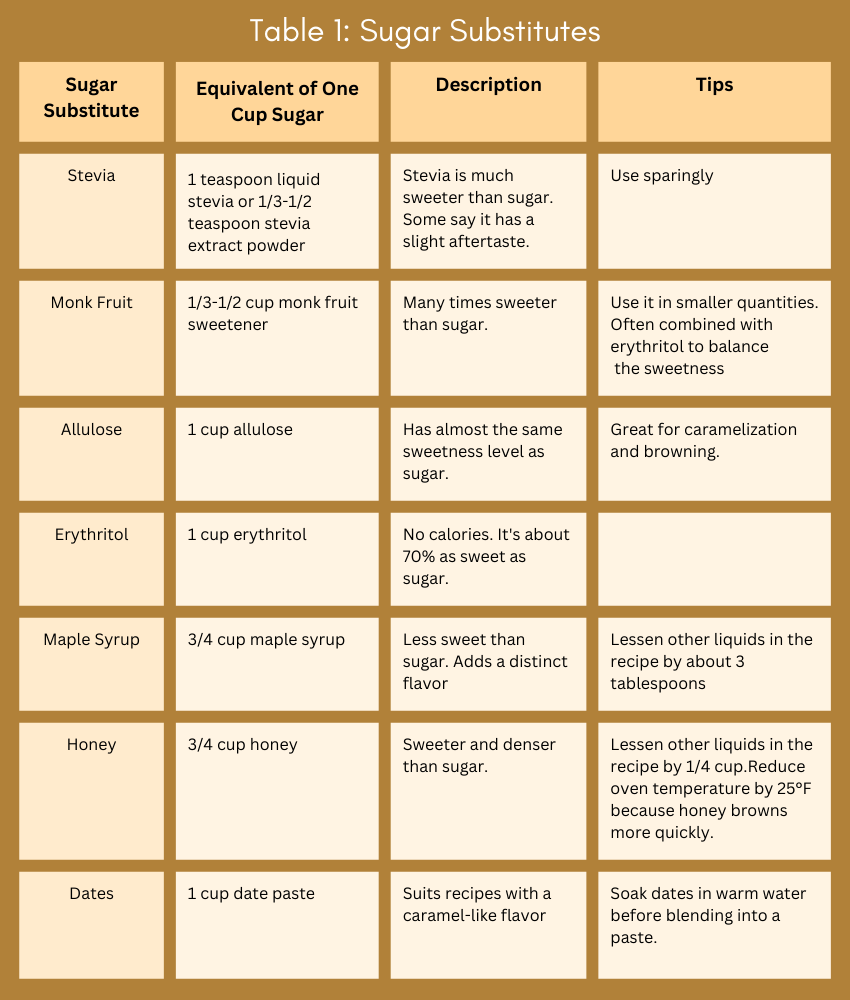
2. What are healthy substitutes for flour?
Whether you want to increase fiber or go gluten-free, several healthy flour substitutes for baking exist.
Whole-grain flour, such as whole wheat and spelt, can increase the fiber and protein in baked goods, giving you a fuller feeling. However, it can also lend a heavier texture to baked goods.
On the other hand, gluten-free flours like almond, coconut, and oat flour work great for those with gluten intolerance. Be prepared for a bit of a texture change and a hint of their inherent flavors.
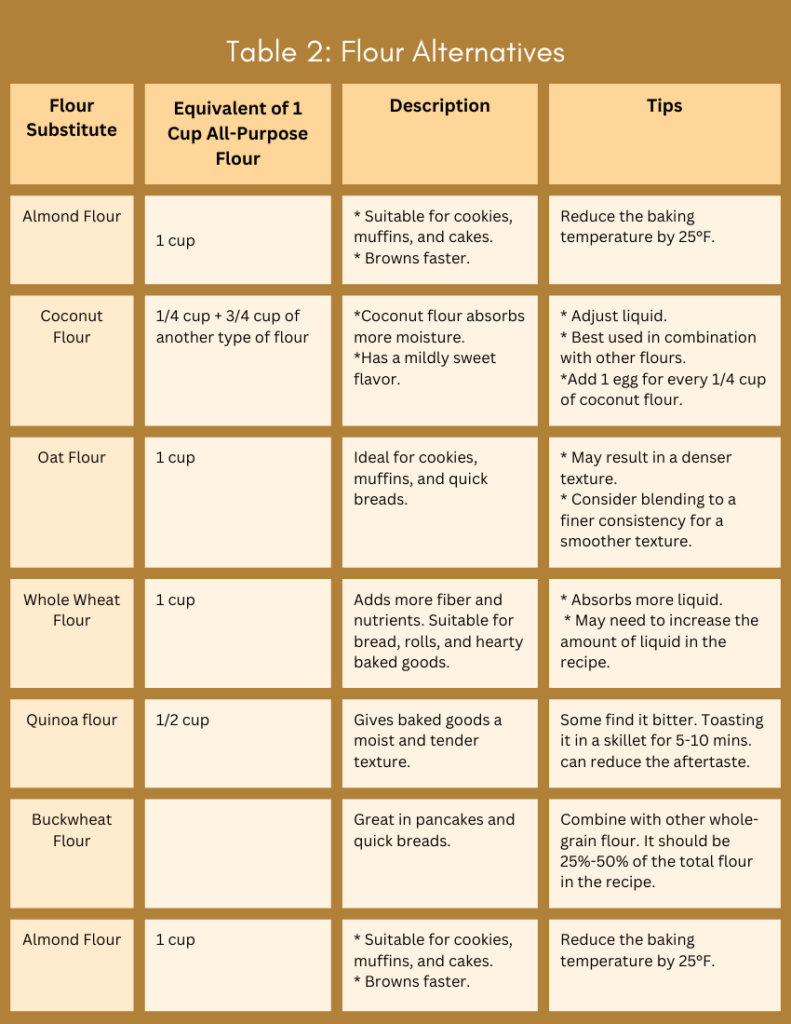
3. Healthy Baking Substitutions For Oil and Butter
As unconventional and surprising as it may sound, avocados, Greek yogurt, and applesauce are healthy substitutes for butter and oil in your recipes. They keep your cakes moist while packing them with nutrients.
In Table 3, you’ll see more healthy fats you can use.
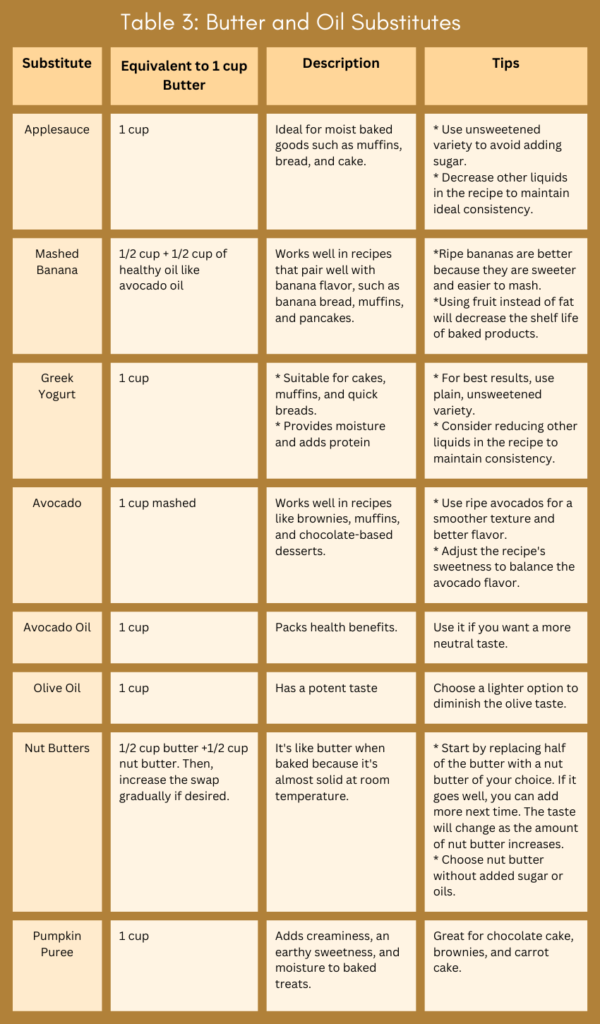
4. Healthy Alternatives To Eggs
Vegans or those with egg allergies don’t have to eschew baked treats because plant-based substitutes like flaxseeds, chia seeds, and applesauce can help bind ingredients like eggs.
Note: You cannot replace eggs in some recipes, like custard.
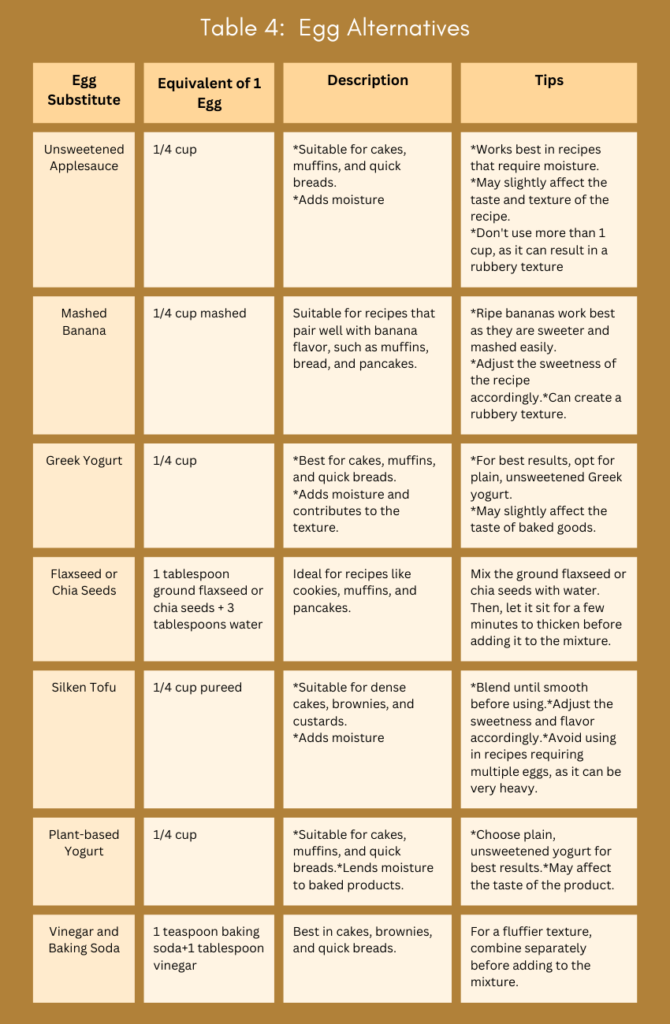
5. Healthy Dairy Alternatives
I have been lactose intolerant for the longest time. I can tolerate a bit of dairy. But the amount in most treats, like custard and chocolate cakes, sends my gut into overdrive.
I soon learned that there are dairy alternatives that are as nutritious or even more nutritious.
Keep scrolling.
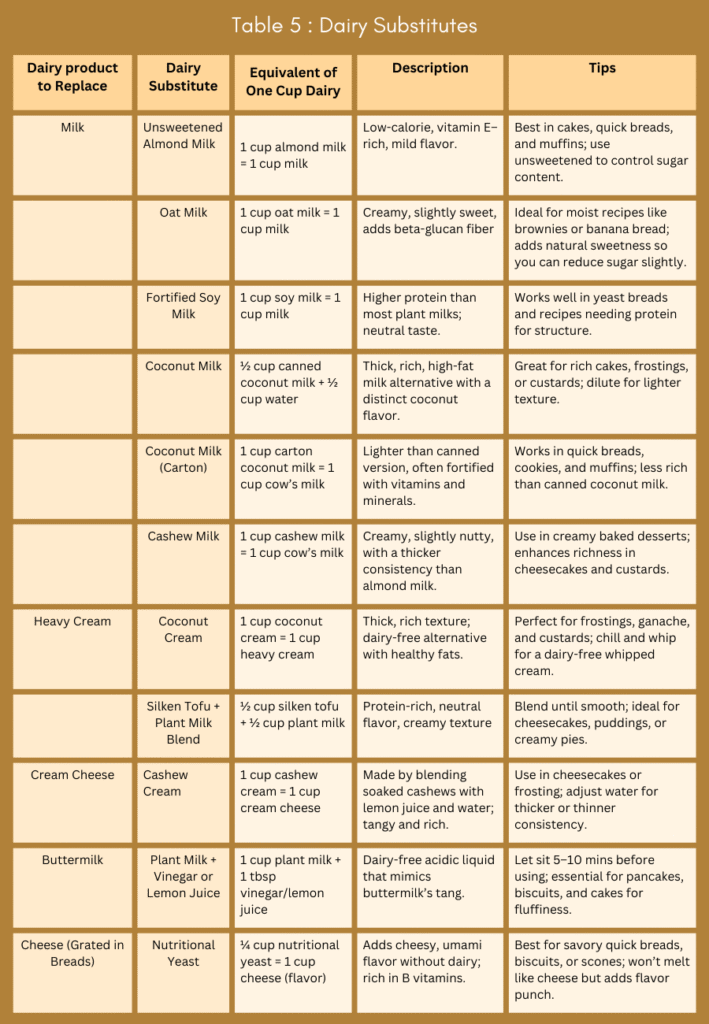
Reminder!
The substitution measures are general ratios. You may need to adjust them depending on your recipe. Always start with smaller amounts and alter them as necessary.
There you have it…a comprehensive guide as you journey into healthy baking through ingredient substitution.
Better for You: Nutritional Benefits of Healthy Baking Swaps
Sugar Swaps:
1. Honey is a source of phenolic compounds and flavonoids, which can help reduce oxidative stress and inflammation in the body.
Some types of honey exhibit antimicrobial properties, which can aid in wound healing and fight infectious bugs.
It has relatively low amounts of minerals like calcium, potassium, iron, zinc, and magnesium.
2. Maple Syrup. Like honey, it contains antioxidants that can help neutralize free radicals in the body.
It provides small amounts of essential minerals like calcium, potassium, iron, and zinc.
3. Dates are a good source of dietary fiber.
They contain vitamin B6 and minerals such as potassium, magnesium, and iron.
4. Stevia is virtually calorie-free. It is an excellent choice if you are striving to reduce calorie intake or manage weight.
Are you limiting your sugar intake or following a low-carb or ketogenic diet? Stevia might suit you as it does not raise blood sugar levels.
Like stevia, monk fruit and allulose have meager calories and do not significantly affect blood sugar levels.
I can almost hear you think you can indulge in your cravings as much as you want because these sweet substitutes have health benefits.
I don’t think you should. These natural sugar substitutes are nutritionally better than refined sugar, but you should consume them in moderation as part of a balanced diet.
Flour Swaps:
1. Almond flour is rich in heart-healthy monounsaturated fats. This nut alternative can help improve cholesterol levels and support cardiovascular health.
It is a good source of magnesium, omega-3 fatty acids, and vitamin E.
Are you looking to up your protein intake? Consider using this flour swap as it contains protein.
It is also a low-carb and gluten-free replacement for white flour.
2. Coconut flour is a rich source of antioxidants and dietary fiber. It’s also a good source of protein and minerals like iron and potassium.
3. Whole wheat flour is the best-known white flour substitute. It is not gluten-free, but the high amounts of fiber it provides make it a wiser choice over its white cousin.
It’s also a good source of the essential B vitamins: thiamin, riboflavin, niacin, and folate.
Plus, it contains the minerals magnesium, zinc, and iron.
4. Oat flour is abundant in beta-glucans, a type of soluble fiber. They have become popular because they help lower cholesterol and stabilize blood sugar.
Oat flour also contains manganese, phosphorus, and magnesium minerals, as well as B vitamins like thiamin and pantothenic acid.
5. Quinoa Flour is a source of iron, protein, fiber, healthy unsaturated fats, and antioxidants.
6. Buckwheat flour is a source of protein, fats and carbohydrates. It contains potassium, magnesium, phosphorus, iron, thiamin, folate, niacin, riboflavin, vitamin B6 and vitamin K
7. Gluten-free flour mixes are combinations of different flours that mimic the texture and properties of ordinary wheat flour. They can include rice flour, potato starch, tapioca flour, and other gluten-free options.
Fat Swaps:
1. Applesauce
- Low-fat alternative to butter and oils
- Contains dietary fiber and potassium.
- Lends a natural sweetness, making it possible to reduce sugar in the recipe.
2. Banana
- Natural sweetness reduces added sugar in baked treats.
- It is a rich potassium source, essential for heart and muscle function.
- It provides moisture, reducing or eliminating the need for fats like butter and oil.
3. Avocado
- A rich source of healthy monounsaturated fats that aid in reducing LDL cholesterol (bad cholesterol).
- They pack almost 20 vitamins and minerals like potassium, vitamin E, and vitamin C.
4. Nut Butters (Almond Butter and Peanut Butter)
- Contain proteins, fibers and a rich source of healthy fats.
- A good source of various vitamins and minerals
5. Olive Oil
- Contains healthy monounsaturated fats.
- Rich in antioxidants.
6. Greek Yogurt
- Boosts proteins in recipes.
7. Pumpkin Puree
- Provides fiber, vitamin A, and potassium.
Egg Swaps:
- Flaxseeds
- An excellent source of alpha-linolenic acid and omega-3 fatty acids. These fats are essential for brain and heart health and reducing inflammation.
- Rich in soluble and insoluble fibers.
- One of the best sources of a type of antioxidants and phytoestrogens called lignans.
- A good source of essential minerals and vitamins.
2. Chia Seeds
- Like flaxseeds, it’s also an excellent source of alpha-linolenic acid.
- Rich in dietary fibers.
- Provides a considerable amount of plant-based protein.
- Contains antioxidants, such as flavonoids and polyphenols.
- A good source of essential minerals like calcium, magnesium, phosphorus, and manganese.
3. Silken Tofu
- Contains all the essential amino acids necessary for building and repairing tissues in the body.
- Contains healthy unsaturated fats, including omega-3 and omega-6 fatty acids.
- A rich source of the essential minerals calcium, iron, magnesium, manganese, phosphorus, copper, and selenium.
- A good source of several B vitamins, such as thiamin, niacin, riboflavin, and vitamin B6.
- Contains natural plant compounds called isoflavones, which act as phytoestrogens
You don’t want to miss this next part.
Tips and Techniques for Successful Healthy Baking
I know you’re always looking for tips and techniques to up your baking game.
Our helpful pointers here will help you achieve that.
1. Have a solid grasp of the science behind baking
This Number one tip is non-negotiable because it will be your foundation when altering traditional recipes to suit your and your family’s health needs.
A thorough knowledge of the science of baking will give you the confidence to try new recipes and eventually make it easier to make swaps and combinations.
And now, you’re thinking, “Boy, I still have to research the science”?
The answer? This ultimate guide to baking science.
2. Understand the roles of each ingredient in baking
Every ingredient in your baking arsenal has a part to play, like actors in a play.
Flour provides the foundation on which to build your baked creations.
Fat brings moisture and tenderness to your baked goods.
Sugar is not just a sweet talker; it also tenderizes and gives color.
Eggs, well, they’re the pillars, providing structure and leavening.
The challenge lies in understanding these roles when you’re shaking things up with substitutions.
3. The importance of accurate measurements
Imagine building a house without a measuring tape; you wouldn’t know where to start.
Baking is pretty much the same; it’s both science and art. Measuring ingredients accurately, especially when swapping them out, is essential because…
- It ensures your baked treats don’t turn into kitchen mishaps.
- It is easy to determine which ingredients you still have to adjust if the result is not to your liking.
- It’s convenient to recreate successful bakes.
Trust us; your kitchen scale will soon become your new best friend.
4. Go slow
You should replace one ingredient at a time. That way, you will know exactly how it affects taste and texture.
Making two or three simultaneous substitutions will make it harder to nail the right combination.
5. Techniques to maintain texture and flavor
Do you fear that your healthy baked goodies will taste like cardboard? Been there, done that.
A key technique is balancing your ingredients. If you’re using heavier whole-grain flour, try to pair it with white flour.
Or, if you’re using stevia, known to leave a bitter aftertaste, mellow it down with a bit of honey or maple syrup. It’s all about finding that sweet spot.
6. Secret ingredients: Spices and flavor extracts
What is life without spices and flavors? So it is with baking.
Spices and flavor extracts are your secret weapons in baking. They bring depth to flavors; a small amount can transform your baked creations from okay to magical.
- Vanilla extract enhances sweetness and works its magic in a variety of baked goods, such as cookies, cakes, and pastries.
- Cinnamon adds a comforting, spicy note to your apple pies or carrot cakes.
- Ginger’s zesty vibe brings a spark of life to your gingersnap cookies or spice cakes.
- Nutmeg provides a sweet, nutty depth to creamy dishes, apple pies, or pumpkin bread.
- And cardamom? Its unique sweet and spicy notes make simple banana bread feel like an exotic treat.
6. Record, record, record
Write down every modification you make and the outcomes.
Take note of the texture and taste.
Next, note what you need to adjust and by how much. Should you alter the procedure? Add steps? Note everything.
Why?
Don’t you want to recreate precisely the recipes you got right after several attempts at tweaking?
I’m sure you do.
Imagine the pain of trying to recall and not being sure of the adjustments you made.
Your collection of healthier recipes will be a treasure trove you can pass on to your children and grandchildren. You can even share them on your social media and maybe even earn from them. Who knows?
7. Take it from others
Here’s a shortcut…don’t start from scratch.
You can find lots of healthy baking recipes online. Just search for no-sugar, gluten-free, low-fat, etc.
Some blogs focus on healthy baking. And they are good ones to learn from.
You may find some that are right for you and don’t need further tweaking or some that you want to modify.
For example, you looked for a sugar-free banana cake recipe with healthier fats. You found one that uses butter and stevia instead of regular sugar.
After removing the sugar, you only have to replace the butter with a healthier fat source, adjusting as necessary.
Saves you time, effort, and resources.
Do you have to apply all these tips and techniques? Not all, but most of them if you want to simplify ingredient substitution.
A New Dawn in Your Baking Journey
It’s natural to feel a touch of apprehension at the thought of tweaking beloved family recipes.
They’ve warmed hearts and filled tummies for years. Their delicious familiarity is the stuff of sweet memories and tradition.
You might wonder, “Can my favorite chocolate chip cookies still taste the same without all the sugar? What if my kids don’t love the brownies with whole grain flour?”
Here’s the thing, though – your love for your family and your passion for baking have led you down this path of exploration.
Each substitute you’ve learned about isn’t merely a healthier option.
They’re the key to unlocking a new world of flavors and textures.
Take what you’ve learned and start whipping up healthier delights.
You can with healthy baking substitutes.
Remember your goal for yourself and your loved ones: the freedom to indulge without worry.
